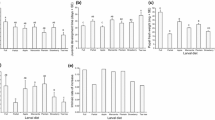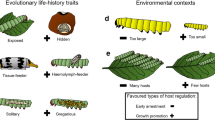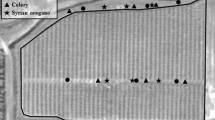Abstract
Consumers do not always utilize all suitable hosts. Understanding why parasitic plants do not always parasitize potentially suitable hosts requires a better understanding of the constraints that limit host use by parasitic plants. In Texas salt marshes, the parasitic plant Cuscuta indecora rarely parasitizes three hosts that support vigorous growth in the greenhouse. We identified three constraints on host use by C. indecora. First, a mismatch between the phenology of C. indecora and some suitable hosts meant that these hosts were not abundant when C. indecora was growing most vigorously, and therefore were underutilized. Second, C. indecora preferentially parasitized tall plants versus short ones, causing relatively short species to be underutilized. Third, C. indecora overwinters in some perennial hosts but has to reinfect annual hosts each year, causing annuals and perennials that do not support overwintering to be underutilized. In combination, these constraints, which reflect the general lack of mobility of parasitic plants relative to herbivores, remove half of the potential host species from the actual diet of C. indecora, and therefore likely represent a major limitation on the success of this parasite. Similar constraints are likely to limit the realized host range of many parasitic plants and select for generalized diet preferences.





Similar content being viewed by others
References
Archibald S, Bond WJ (2003) Growing tall vs. growing wide: tree architecture and allometry of Acacia karroo in forest, savanna, and arid environments. Oikos 102:3–14
Atsatt PR (1977) The insect herbivore as a predictive model in parasitic seed plant biology. Am Nat 111:579–612
Atsatt PR (1983) Host-parasite interactions in higher plants. In: Lange O, Nobel P, Osmond C, Ziegler H (eds) Encyclopedia of plant physiology. Springer, Berlin, pp 519–535
Atsatt PR, Strong DR (1970) The population biology of annual grassland hemiparasites. I. The host environment. Evolution 24:278–291
Bernstein L (1975) Effects of salinity and sodicity on plant growth. Annu Rev Phytopathol 13:295–312
Bond WJ, Loffell D (2001) Introduction of giraffe changes acacia distribution in a South African savanna. Afr J Ecol 39(3):286–294
Callaway RM, Pennings SC (1998) Impact of a parasitic plant on the zonation of two salt marsh perennials. Oecologia 114:100–105
Chuang T-I, Heckard LR (1971) Observations on root-parasitism in Cordylanthus (Scrophulariaceae). Am J Bot 58:218–228
Clay K, Kover PX (1996) The red queen hypothesis and plant/pathogen interactions. Annu Rev Pyhtopathol 34:29–50
Dawson JH, Musselman LJ, Wolswinkel P, Dörr I (1994) Biology and control of Cuscuta. Rev Weed Sci 6:265–317
Dean HL (1937) Gall formation in host plants following haustorial invasion by Cuscuta. Am J Bot 24:167–173
Dean HL (1954) Dodder overwintering as haustorial tissues within Cuscuta-induced galls. Proc Iowa Acad Sci 61:99–106
Forkner RE, Marquis RJ, Lill JT, Corff JL (2008) Timing is everything? Phenological synchrony and population variability in leaf-chewing herbivores of Quercus. Ecol Entomol 33(2):276–285
Gehring CA, Whitham TG (1992) Reduced mycorrhizae on Juniperus monosperma with mistletoe: the influence of environmental stress and tree gender on a plant parasite and a plant-fungal mutualism. Oecologia 89:298–303
Gibson CC, Watkinson AR (1989) The host range and selectivity of a parasitic plant: Rhinanthus minor L. Oecologia 78:401–406
Gibson CC, Watkinson AR (1991) Host selectivity and the mediation of competition by the root hemiparasite Rhinanthus minor. Oecologia 86:81–88
Gilman EF (1999) Lycium carolinianum. FPS-356. Environmental Horticulture Department, Florida Cooperative Extension Service, Institute of Food and Agriculture Sciences, University of Florida
Goranson CE, Ho C-K, Pennings SC (2004) Environmental gradients and herbivore feeding preferences in coastal salt marshes. Oecologia 140:591–600
Hacker SD, Bertness MD (1995) An herbivore paradox: why salt marsh aphids live in poor quality plants. Am Nat 145:192–210
Hamilton WD, Axelrod R, Tanese R (1990) Sexual reproduction as an adaptation to resist parasites (a review). Proc Natl Acad Sci 87:3566–3573
Hurst LH, Peck JR (1996) Recent advances in understanding of the evolution and maintenance of sex. Trends Ecol Evol 11:A46–A52
Kelly CK (1990) Plant foraging: a marginal value model and coiling response in Cuscuta subinclusa. Ecology 71:1916–1925
Kelly CK (1992) Resource choice in Cuscuta europaea. PNAS 89:12194–12197
Kelly CK, Horning K (1999) Acquisition order and resource value in Cuscuta attenuata. PNAS 96:13219–13222
Kuijt J (1969) The biology of parasitic plants. University of California Press, Berkeley
Kunza AE, Pennings SC (2008) Patterns of plant diversity in Georgia and Texas salt marshes. Estuaries Coasts 31:673–681
Lipsitch M, Nowak MA, Ebert D, May RM (1995) The population dynamics of vertically and horizontally transmitted parasites. Proc R Soc Lond B260:321–327
Matthies D (1996) Interactions between the root hemiparasite Melampyrum arvense and mixtures of host plants: heterotrophic benefit and parasite-mediated competition. Oikos 75:118–124
Matthies D (1998) Influence of the host on growth and biomass allocation in the two facultative root hemiparasites Odontites vulgaris and Euphrasia minima. Flora 193:187–193
Meulebrouck K, Ameloot E, Brys R, Tanghe L, Verheyen K, Hermy M (2009) Hidden in the host—unexpected vegetative hibernation of the holoparasite Cuscuta epithymum (L.) L. and its implications for population persistence. Flora 204:306–315
Mitchell FJG, Kirby KJ (1990) The impact of large herbivores on the conservation of semi-natural woods in the British uplands. Forestry 63(4):333–353
Moon D, Stiling P (2000) Relative importance of abiotically induced direct and indirect effects on a salt marsh herbivore. Ecology 81:470–481
Mopper S, Simberloff D (1995) Differential herbivory in an oak population—the role of plant and insect performance. Ecology 76:1233–1241
Musselman LJ, Press MC (1995) Introduction to parasitic plants. In: Press MC, Graves JD (eds) Parasitic plants. Chapman and Hall, London, pp 1–13
Norton DA, De Lange PJ (1999) Host specificity in parasitic mistletoes (Loranthaceae) in New Zealand. Funct Ecol 13:552–559
Pennings SC, Bertness MD (2001) Salt marsh communities. In: Bertness MD, Gaines SD, Hay ME (eds) Marine community ecology. Sinauer, Sunderland
Pennings SC, Callaway RM (1996) Impact of a parasitic plant on the structure and dynamics of salt marsh vegetation. Ecology 77:1410–1419
Pennings SC, Callaway RM (2002) Parasitic plants: parallels and contrasts with herbivores. Oecologia 131:479–489
Pennings SC, Simpson JC (2008) Like herbivores, parasitic plants are limited by host nitrogen. Plant Ecol 196:245–250
Press MC, Graves JD (1995) Parasitic plants. Chapman and Hall, London
Press MC, Graves JD, Stewart GR (1990) Physiology of the interaction of angiosperm parasites and their higher plant hosts. Plant Cell Environ 13:91–104
Runyon JB, Mescher MC, De Moreas CM (2006) Volatile chemical cues guide host location and host selection by parasitic plants. Science 313:1964–1967
Seel WE, Press MC (1993) Influence of the host on three sub-Arctic annual facultative root hemiparasites. I. Growth, mineral accumulation and above-ground dry-matter partitioning. New Phytol 125:131–138
Seel WE, Press MC (1994) Influence of the host on three sub-Arctic annual facultative root hemiparasites. II. Gas exchange characteristics and resource use-efficiency. New Phytol 127:37–44
Seel WE, Cooper RE, Press MC (1993) Growth, gas exchange and water use efficiency of the facultative hemiparasite Rhinanthus minor associated with hosts differing in foliar nitrogen concentration. Physiol Plant 89:64–70
van Asch M, Visser ME (2007) Phenology of forest caterpillars and their host trees: the importance of synchrony. Annu Rev Entomol 52:3755
Watkinson AR, Gibson CC (1988) Plant parasitism: the population dynamics of parasitic plants and their effects upon plant community structure. In: Davy AJ, Hutchings MJ, Watkinson AR (eds) Plant population ecology. Blackwell, Oxford, pp 393–411
Acknowledgments
We thank the University of Houston Coastal Center for funding. We thank M. Noorbhai and L. Wason for help in the field and greenhouse, R. Azevedo, W. Rogers, J. Rudgers, and R. Zufall for discussion, and two anonymous reviewers for constructive comments.
Author information
Authors and Affiliations
Corresponding author
Additional information
Communicated by Meelis Partel.
Rights and permissions
About this article
Cite this article
Marquardt, E.S., Pennings, S.C. Constraints on host use by a parasitic plant. Oecologia 164, 177–184 (2010). https://doi.org/10.1007/s00442-010-1664-7
Received:
Accepted:
Published:
Issue Date:
DOI: https://doi.org/10.1007/s00442-010-1664-7




